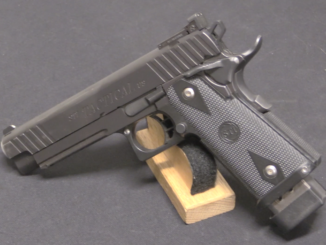With the death of Jonathan “Ed” Browning in 1939, development of the Winchester G30 rifle was passed into the hands of a new employee at Winchester by the name of David Marshall Williams. Williams would become widely known as “Carbine” Williams in later years thanks to Jimmy Stewart and Hollywood, but we will be to that part of this story later.
What Williams did to the G30 was to replace Browning’s annular gas piston with his own short stroke tappet system (this being the first rifle to use that system of Williams’). This substantially improved the gun’s reliability, and Winchester was able to submit it to Marine Corps trials in 1940 alongside the Garand and Pedersen rifles under the designation G30M. The Marine Corps was legitimately interested in the G30M, as it was expected to be both faster and cheaper to manufacture than the Garand.
Ultimately the trials were won by the Garand, with the G30M placing third in total malfunctions and broken parts. This had involved 37 different tests and more than 12,000 rounds through each rifle. The Garand had 1,480 total malfunctions and 49 parts broken, replaced, or repaired. The Johnson had 1,547 and 72 respectively, and the G30M 2,864 and 97 (roughly double the number of problems as the Garand).
Despite this failure, Winchester was encouraged to continue working on the rifle, if for no other reason than the possibility of foreign purchasers. Williams’ next step would be to replace the Browning tilting bolt with a Garand-type rotating bolt, which would result in a rifle Winchester would call the M2, or “the seven and a half pound rifle”. We will examine that rifle in the next video…




By the way: do you have plans to examine Carbine Williams’s first rifles in the North Carolina Museum of History (http://www.uscarbinecal30.com/Williams3.html)?
Thanks for the excellent site.
“possibility of foreign purchasers”
Who was potential customer?
Other question: Does Winchester tried to alter Winchester Model 1907 to appeal more to military clients: bigger magazine, bayonet lug or fire mode selector?
Additional though: could be G30M be redesigned to become successful sporting rifle – say .270 Winchester, other furniture e.t.c.? I think such self-loading rifle might be precious addition to Winchester offer: .401 Winchester Self-Loading fire light-for-caliber round-nose bullet which mean restricted range.
Do you mean now or historically? External ballistics were not really that important for hunting rifle “effective” ranges prior to the development of affordable high magnification optics. Ranges were limited by the shooter’s ability to get a good hit with iron sights on the first shot.
“now or historically”
In 1940s.
https://en.wikipedia.org/wiki/.401_Winchester_Self-Loading
states that .401 Winchester Self-Loading proved powerful enough for both deer and other large game at ranges under 150 yards.. Isn’t that smaller than what “iron sights” allow?
Can really see the shape of the M1 Carbine developing on the model with the flush magazine, very cool.
Well executed units; wish to see them fire.
Tappet is popular again, they have it on ARX. Is it somehow immune to clogging?
http://cdn2.hubspot.net/hub/302700/file-1664731940-jpg/Beretta_ARX100-12.jpg?t=1413497172615
I don’t think it’s immune to clogging but having a proper gas piston surely keeps the chamber from fouling a bit longer. The HK-416 is an example of improvement over the AR-15 in keeping ammunition propellant quality from messing with the receiver area… Or am I wrong?
“HK-416”
I just read Heckler & Koch HK416 query in Wikipedia which states that:
project was originally called the Heckler & Koch M4, but this was changed in response to a trademark infringement suit filed by Colt Defense.
I am (as always) confused about U.S. law, I would rather suspect that M4 designation was created by Army, not manufacturer.
“Tappet is popular again”
If FN SCAR query in Wikipedia is true then this weapon is also TAPPET. Does anyone have any users opinions about it reliability or malfunction-rate?
“Or am I wrong”
On the other it is possible to make successful direct gas impingement weapon, namely MAS-49:
http://world.guns.ru/rifle/autoloading-rifles/fr/mas-1949-and-4956-e.html
I don’t know français but considered that it was produced for many years, it must be good enough.
My interpretation of a gas system where piston is permanently (meaning not accessible for routine cleaning) enclosed and transfers momentum in measured (travel and force) way to breech mechanism is – tappet.
Is that in line with your understanding?
I think it is all matter of access for cleaning. The tappet used on .30cal carbine cannot be accessed for cleaning without tools/ major disassembly. So seem to be case (for lack of detailed knowledge on my part) with Beretta. On HK416 the outer piston/ cup is part of disassembly routine. So, they are not exactly the same sub-category.
Overall, tapper seem to be super idea and survived to this day.
For AR16/ M16 there are as part of cleaning kit supplied swabs which are intended for gas tube cleaning. Gas tube can be removed after being released from front sight post (base) by pushing out retention pin. This is probably not done on regular bases, but I am not sure; probably depends on type of service/user. But piston and carrier’s gas compartment are typically subject to cleaning.
There are no “swabs” for cleaning the gas tube in the cleaning kit for the M16 or M4.
Nor is the gas tube ever removed for cleaning.
With properly specified and manufactured ammunition, there is no need for any cleaning of the gas tube. The M16’s problems with the gas system were entirely due to the improper manufacturing of the early lots of 5.56mm ball. Since the proper ammunition was put in use, there have been no further issues with the gas tube.
I am an idiot that just stepped out of anouthouse,but i like the substantial improvement in the gas system and op-rod.